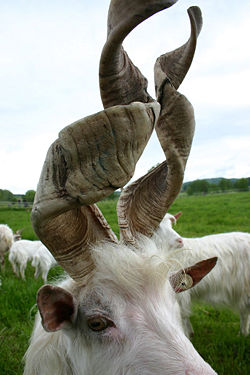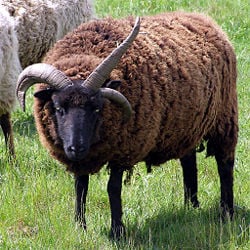Difference between revisions of "Horn (anatomy)" - New World Encyclopedia
Rick Swarts (talk | contribs) |
Rick Swarts (talk | contribs) |
||
| Line 1: | Line 1: | ||
{{otheruses|Horn}} | {{otheruses|Horn}} | ||
[[Image:Goat with spiral horns.jpg|thumb|250px|A [[goat]] with spiral horns]] | [[Image:Goat with spiral horns.jpg|thumb|250px|A [[goat]] with spiral horns]] | ||
| − | + | In [[zoology]], a '''horn''' is one of a pair of hard, pointed, often permanent projections on the [[head]] of various hoofed [[mammal]]s ([[ungulates]]) consisting of a core of living [[bone]] covered by a sheath of [[keratin]] and other [[protein]]s. Examples of animals with true horns include antelopes, cattle, and goats. The term also is used to refer more specifically to the hard keratinous material forming this outer covering. | |
| + | |||
| + | While both a bony core and a covering of keratinous material constitute the definition of a true horn, there are many other hard structures projecting from the head of animals that do not meet these requirements but commonly are known as horns. These include the antlers of deer (dead bone without horn covering), | ||
| + | rhinoceros (have keratin but lack a bony core) | ||
| + | giraffe (formed from ossified cartilage and are called ossicones skin-covered bony knobs | ||
| + | |||
| + | ==Overview== | ||
| + | bone | ||
| + | keratin | ||
| + | |||
| + | True horns are found only among the [[ruminant]] [[artiodactyl]]s,{{Fact|date=December 2007}} in the families [[Antilocapridae]] ([[pronghorn]]) and [[Bovidae]] ([[cattle]], [[goat]]s, [[antelope]] etc.). These animals have one or occasionally two pairs of horns, which usually have a curved or [[spiral]] shape, often with ridges or fluting. In many species only the males have horns. Horns start to grow soon after birth, and continue to grow throughout the life of the animal (except in [[Antilocapridae|pronghorns]], which shed the outer layer annually, but retain the bony core). Similar growths on other parts of the body are not usually called horns, but [[spur]]s, [[claw]]s or [[hoof]]s. | ||
:Antelopes are ruminants. Like other ruminants, such as cattle, goats, and sheep, | :Antelopes are ruminants. Like other ruminants, such as cattle, goats, and sheep, | ||
Revision as of 19:37, 11 October 2008
- For other uses, see Horn (anatomy) (disambiguation).

In zoology, a horn is one of a pair of hard, pointed, often permanent projections on the head of various hoofed mammals (ungulates) consisting of a core of living bone covered by a sheath of keratin and other proteins. Examples of animals with true horns include antelopes, cattle, and goats. The term also is used to refer more specifically to the hard keratinous material forming this outer covering.
While both a bony core and a covering of keratinous material constitute the definition of a true horn, there are many other hard structures projecting from the head of animals that do not meet these requirements but commonly are known as horns. These include the antlers of deer (dead bone without horn covering), rhinoceros (have keratin but lack a bony core) giraffe (formed from ossified cartilage and are called ossicones skin-covered bony knobs
Overview
bone keratin
True horns are found only among the ruminant artiodactyls,[citation needed] in the families Antilocapridae (pronghorn) and Bovidae (cattle, goats, antelope etc.). These animals have one or occasionally two pairs of horns, which usually have a curved or spiral shape, often with ridges or fluting. In many species only the males have horns. Horns start to grow soon after birth, and continue to grow throughout the life of the animal (except in pronghorns, which shed the outer layer annually, but retain the bony core). Similar growths on other parts of the body are not usually called horns, but spurs, claws or hoofs.
- Antelopes are ruminants. Like other ruminants, such as cattle, goats, and sheep,
Both sexes of most antelope species grow horns, with the males' horns generally larger.
Other hornlike growths
The term "horn" is also popularly applied to other hard and pointed features attached to the head of animals in various other families:
- Giraffidae: Giraffes have one or more pairs of bony bumps on their heads, called ossicones. These are covered with furred skin, and although they look as if they ought to have horns on them, they do not.
- Cervidae: Most deer have antlers, which are not true horns. When fully developed antlers are dead bone without a horn or skin covering; they are borne only by adults (usually males) and are shed and regrown each year.
- A characteristic of deer is that almost all species have antlers, a biological structure that is unique to deer. Other ruminants have horns. Antlers consist of bony outgrowths from the head with no covering of keratin as is found in true horns.
- Rhinocerotidae: The "horns" of rhinoceroses are made of keratin and grow continuously, but do not have a bone core.
- Rhinoceros have one or two projections on the upper snout. These "horns" are not really true horns, but are epidermal derivatives, composed of a solid mass of thickly matted hair—keratin, a hair protein—that grows from the skull without skeletal support.
- Ceratopsidae: The "horns" of the Triceratops were extensions of its skull bones although debate exists over whether they had a keratin covering.
- Horned lizards (Phrynosoma): These lizards have horns on their heads which have a hard keratin covering over a bony core, like mammalian horns.
- Monodontidae: Male narwhals have a single long tusk, a modified tooth, which looks like a horn, and is twisted like that of the fictional unicorn.
- Insects: Some insects (such as rhinoceros beetles) have horn-like structures on the head or thorax (or both). These are pointed outgrowths of the hard chitinous exoskeleton. Some (such as stag beetles) have greatly enlarged jaws, also made of chitin.
The family Acrididae ("short-horned grasshoppers") of the suborder Caelifera and the family Tettigoniidae ("long-horned grasshoppers") of the suborder Ensifera. Alternatively, "grasshopper" sometimes refers only to the Acrididae, which are then called "true grasshoppers," or in other instances the name is applied exclusively to the entire suborder Caelifera (Capinera et al. 2006). antennae Tettigoniidae (long-horned grasshoppers) are typified by antennae longer than the body, while the Acrididae (short-horned grasshoppers) have antennae shorter than the body.
Many mammal species in various families have tusks, which often serve the same functions as true horns, but are in fact oversize teeth. These include the Moschidae (Musk deer, which are ruminants), Suidae (Wild Boars), Proboscidea (Elephants), Monodontidae (Narwhals) and Odobenidae (Walruses).
Polled animals or pollards are those of normally-horned (mainly domesticated) species whose horns have been removed, or which have not grown. In some cases such animals have small horny growths in the skin where their horns would be – these are known as scurs.
Animal uses of horns
Animals have a variety of uses for horns and antlers, including defending themselves from predators and fighting members of their own species for territory, dominance or mating priority. In addition, horns may be used to root in the soil or strip bark from trees. In animal courtship many use horns in displays. For example, the male blue wildebeest reams the bark and branches of trees to impress the female and lure her into his territory. Some animals with true horns use them for cooling, the blood vessels in the bony core allowing the horns to function as a radiator.
Human uses of horns
Use of animal horns is controversial, especially if the animal was specifically hunted for the horn as a hunting trophy or object of decoration or utility. Some animals are threatened or endangered to reduced populations partially from pressures of such hunting.
Some peoples use bovid horns as musical instruments, for example the shofar. These have evolved into brass instruments in which, unlike the trumpet, the bore gradually increases in width through most of its length — that is to say, it is conical rather than cylindrical. These are called horns, though made of metal.
Drinking horns' are bovid horns removed from the bone core, cleaned and polished and used as drinking vessels. (See also the legend of the Horn of plenty, or Cornucopia).
Powder horns were originally bovid horns fitted with lids and carrying straps, used to carry gunpowder. Powder flasks of any material may be referred to as powder horns.
Antelope horns are used in traditional Chinese medicine.
Horn can also refer to keratin, the material of which a horn is made, sometimes including keratin from other parts of animals, such as hoofs. Horn may be used as a material in tools, furniture and decoration, among other uses. In these applications, horn is valued for its hardness, and it has given rise to the expression hard as horn. Horn is somewhat thermoplastic and (like tortoiseshell) was formerly used for many purposes where plastic would now be used. Horn may be used to make glue.
Horn bows are bows made from a combination of horn, sinew and usually wood. These materials allow more energy to be stored in a short bow than wood would.
Ivory comes from the teeth of animals, not horns.
"Horn" buttons are usually made from deer antlers, not true horn.
See also
- Horn (disambiguation page)
- Horn (instrument)
- Horned helmet
- Polled livestock
- Tortoiseshell
External links
Credits
New World Encyclopedia writers and editors rewrote and completed the Wikipedia article in accordance with New World Encyclopedia standards. This article abides by terms of the Creative Commons CC-by-sa 3.0 License (CC-by-sa), which may be used and disseminated with proper attribution. Credit is due under the terms of this license that can reference both the New World Encyclopedia contributors and the selfless volunteer contributors of the Wikimedia Foundation. To cite this article click here for a list of acceptable citing formats.The history of earlier contributions by wikipedians is accessible to researchers here:
The history of this article since it was imported to New World Encyclopedia:
Note: Some restrictions may apply to use of individual images which are separately licensed.
